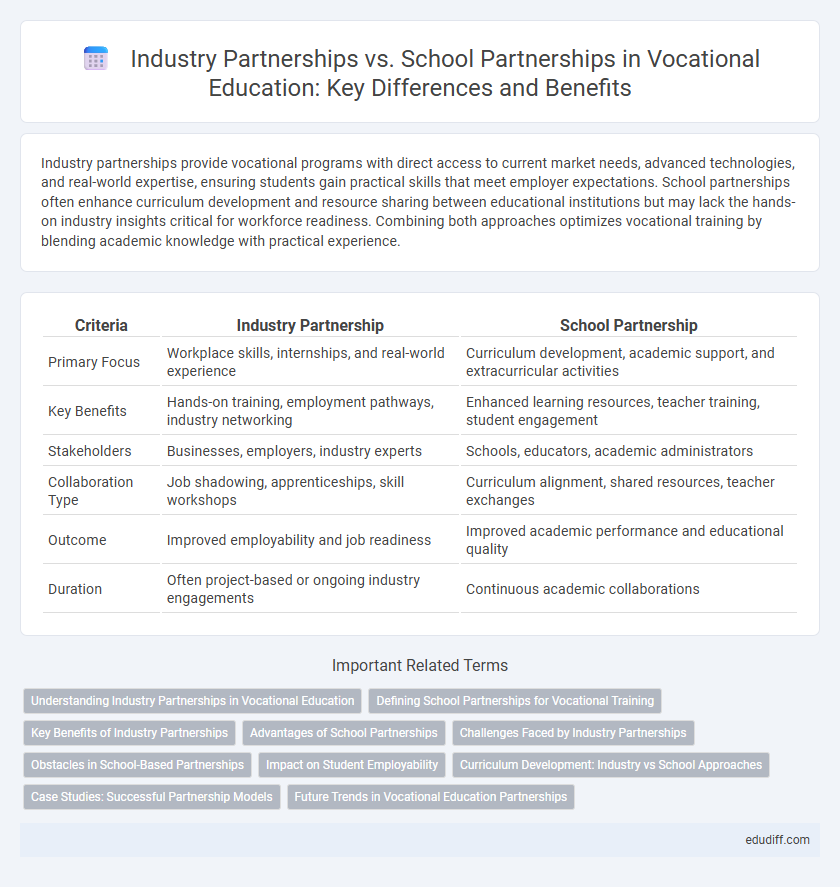Industry partnerships provide vocational programs with direct access to current market needs, advanced technologies, and real-world expertise, ensuring students gain practical skills that meet employer expectations. School partnerships often enhance curriculum development and resource sharing between educational institutions but may lack the hands-on industry insights critical for workforce readiness. Combining both approaches optimizes vocational training by blending academic knowledge with practical experience.
Table of Comparison
| Criteria | Industry Partnership | School Partnership |
|---|---|---|
| Primary Focus | Workplace skills, internships, and real-world experience | Curriculum development, academic support, and extracurricular activities |
| Key Benefits | Hands-on training, employment pathways, industry networking | Enhanced learning resources, teacher training, student engagement |
| Stakeholders | Businesses, employers, industry experts | Schools, educators, academic administrators |
| Collaboration Type | Job shadowing, apprenticeships, skill workshops | Curriculum alignment, shared resources, teacher exchanges |
| Outcome | Improved employability and job readiness | Improved academic performance and educational quality |
| Duration | Often project-based or ongoing industry engagements | Continuous academic collaborations |
Understanding Industry Partnerships in Vocational Education
Industry partnerships in vocational education provide students with direct access to current workforce demands, hands-on training, and real-world experience that align with labor market needs. These collaborations between educational institutions and businesses facilitate curriculum development tailored to industry standards, enhancing employability and skill relevance. By integrating industry expertise, vocational programs ensure graduates are prepared for immediate entry into competitive job sectors.
Defining School Partnerships for Vocational Training
School partnerships for vocational training involve collaboration between educational institutions and industry to design curriculum that aligns with labor market needs. These partnerships prioritize student skill development through hands-on experience, internships, and apprenticeships coordinated between schools and local businesses. The goal is to create pathways for students to transition smoothly into employment by integrating academic learning with practical vocational training.
Key Benefits of Industry Partnerships
Industry partnerships in vocational education provide direct access to current industry standards and technologies, ensuring training programs align with workforce demands. These collaborations offer students real-world experience through internships and apprenticeships, significantly boosting employability and practical skills. Strong industry ties also facilitate resource sharing, curriculum development, and job placement opportunities, driving economic growth and innovation.
Advantages of School Partnerships
School partnerships offer tailored vocational programs aligned with academic curricula, enhancing student skill development within a structured learning environment. These collaborations provide access to school resources, including certified instructors and facilities, ensuring consistent quality and supervision. By fostering a supportive community, school partnerships improve student engagement and career readiness through integrated educational and vocational experiences.
Challenges Faced by Industry Partnerships
Industry partnerships in vocational training face challenges such as aligning curriculum with rapidly evolving market demands and securing sustained investment from businesses. Difficulty in coordinating schedules and expectations between multiple corporate partners often hinders consistent program implementation. Moreover, balancing profit-driven objectives with educational goals creates tension that can impact the quality and accessibility of vocational programs.
Obstacles in School-Based Partnerships
School-based partnerships in vocational education face obstacles such as misaligned goals between educators and industry partners, limited communication channels, and insufficient resources for curriculum adaptation. These challenges hinder the development of relevant skill sets tailored to industry needs, affecting student employability outcomes. Overcoming these barriers requires strategic collaboration frameworks and investment in joint training initiatives.
Impact on Student Employability
Industry partnerships provide students with real-world experience, industry-relevant skills, and direct access to employer networks, significantly boosting employability rates. School partnerships, while valuable for academic support and resource sharing, often lack the direct workforce engagement necessary to align training with current job market demands. Data shows students involved in industry partnerships have higher job placement rates within six months post-graduation compared to those relying solely on school collaborations.
Curriculum Development: Industry vs School Approaches
Industry partnerships prioritize curriculum development that aligns with real-time labor market demands, integrating advanced technologies and practical skills to ensure workforce readiness. School partnerships focus on foundational knowledge and broad academic competencies, emphasizing standardized curricula and pedagogical consistency. Blending industry expertise with educational frameworks creates balanced vocational programs that enhance student employability and adaptability.
Case Studies: Successful Partnership Models
Case studies of vocational education highlight Industry Partnerships as highly effective models, where companies contribute real-world expertise, internships, and up-to-date technology, leading to improved student job readiness. School Partnerships emphasize collaboration between educational institutions, sharing resources and curriculum development to address skill gaps and enhance learning outcomes. Data from successful models like Siemens' collaboration with technical schools and the UK's Gatsby Benchmark show increased employment rates and stronger alignment between training and labor market demands.
Future Trends in Vocational Education Partnerships
Industry partnerships are evolving to prioritize real-time skill demands and technology integration, fostering adaptive curricula aligned with emerging job markets. School partnerships increasingly emphasize collaborative models that combine academic frameworks with hands-on training, enhancing student readiness for diverse career pathways. Future trends indicate a convergence of these partnerships through digital platforms, enabling dynamic engagement between industry experts and educational institutions for personalized vocational learning.
Industry Partnership vs School Partnership Infographic

 edudiff.com
edudiff.com